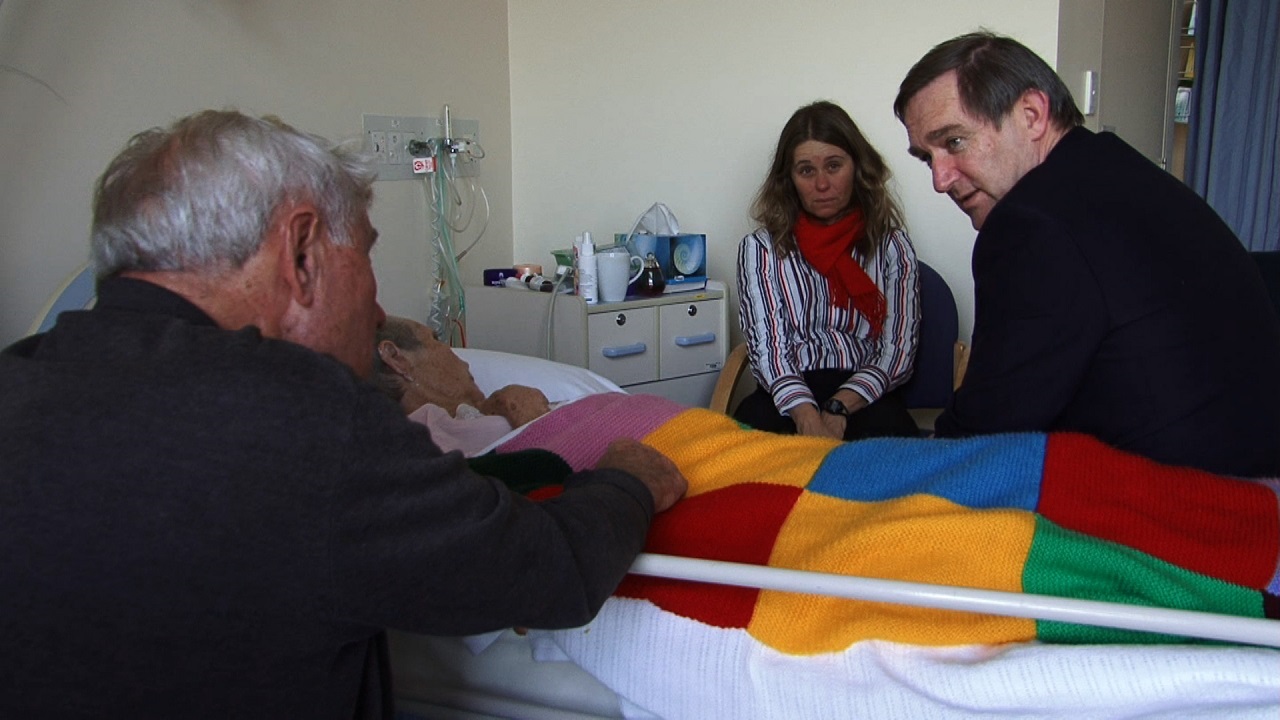Documentary filmed at Sydney hospice screens on world stage
Documentary filmed at Sydney hospice screens on world stage
by Dr Frank Brennan
Monday, October 31, 2016
Palliative care physician Dr Frank Brennan travelled to the International Palliative Care Conference in Montreal earlier this month to present a documentary filmed at a Sydney hospice. Dr Brennan, who features extensively in the film, explains what it was like having film-makers on the ward at Calvary Hospital and how their gentle, respectful approach built the trust of families, patients and staff.
In our work in palliative care stories sit within and around us. Those stories may be spoken privately or expressed in narrative, picture, poetry or film. The Australian documentary film Love in Our Own Time was shown at the recent Montreal International Palliative Care Conference. The film, directed by award- winning documentary film-makers Tom Murray and Madeleine Hetherton, shows a series of patient stories centred on Calvary Hospital, an in-patient palliative care unit in Sydney. Uniquely for a film set in a hospice, the film-makers concurrently followed five pregnant women as they prepared for the birth of their babies. Birth and death. Both are intermingled to striking effect.
The film was received with acclaim by the international audience. The audience members were struck by the extraordinary intimacy Tom was able to capture and the trust the patients, clinicians and staff clearly felt for him.
The genesis of the project commenced when Tom approached me with the idea of making the documentary. Institutional consent was sought and given. Extensive discussions ensued about the underlying objectives, theme and logistics of film-making as well as the nature and philosophy of palliative care. At that point, two worlds met. The film-maker and the clinician. Each had our own skill and craft. Each had our own conventions and demands. And each had our own challenges. Equally, a mutual respect formed between us that allowed an honesty and openness that ultimately made the film immeasurably richer. We realised that this process would be a unique experience, that we would both enter and share the private and intimate domain of the dying of an individual at the closest possible distance. These preliminary discussions proved extremely valuable to the process of film-making and editing.
Prior to filming, Tom and Madeleine simply accompanied me and the junior doctors on ward rounds. Their presence was always explained and consent was sought and given from the patients and their families. Observing without a camera, they began to sense the spirit of the ward, the broad nature of the interactions. This gave all concerned – patients, families and staff – a growing familiarity with the presence of the film-makers. It also gave the film-makers themselves an opportunity to witness the pace and rhythm of a palliative care ward, the routine and the extraordinary, the everyday and the exceptional. Importantly, they saw the weakened patient with a dry mouth, straining to speak to be heard, the worried relative, the sudden burst of emotion, humour and, indeed, epiphany. This unobtrusive, meticulous observation over a considerable period of time meant that when a camera was first used it was barely seen.
Tom’s gentle approach with the patients and their families facilitated his capturing on film some extraordinary moments of vulnerability and intimacy. At one point, a patient woke thinking that he had died and was deeply upset that he hadn’t had a chance to farewell his wife. Tom picks up the moment when the patient, moved and relieved that he has more time, sits with his wife. Another patient breaks down when his family leaves for the day and is gently consoled by a nurse. Equally, with the expectant mothers there is a clarity and intimacy to the film-making, which captures domestic scenes leading up to the birth and their babies.
The film resonates with beginnings and endings, making the circle of life striking. Scenes of birth and death interchange and the audience, drawn into the individual stories, witness these two sacred and unique aspects of all human lives together, side by side. This is further accentuated, in the case of a dying elderly woman, by flickering home movie footage of her and her daughters as small children.
One of the beautiful things Tom does is to set the stories firmly within nature – the views over Botany Bay from the hospice balcony, a child’s reaction to lightning and a city storm, gulls arching across a blue sky. All firmly tie the individual stories to the rhythm of nature including the rhythm of birth, living and dying.
When Love in our Own Time was shown at the Sydney Film Festival all the families present in the film – those who had lost a loved one and the parents of the babies – were invited on stage. Each knew their own story, but not each other’s and to see the whole work, the communal story if you like, resonated through the cinema. The interaction of the families, meeting now for the first time, and the audience was moving and tender.
At the conclusion of the film in Montreal, many members of the audience approached me. They were both moved and curious. Moved by the film’s content and curious as to its antecedence and making. One Canadian clinician said she would use the film as teaching tool. Indeed, a hospice documentary would make an excellent teaching tool for students, raising as it does the issues we confront every day in palliative care.
To purchase the documentary visit http://loveinourowntime.com/
There are two versions – 54 and 93 minutes in duration. The longer version is beautifully paced and includes more interactions between patients and their families.
